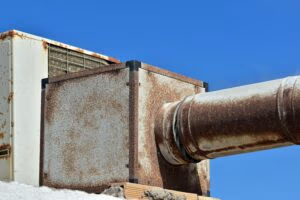Commercial AC Drain Clogs: What Causes Water Leaks and How to Fix Them
Water pooling around your commercial AC unit or dripping from the ceiling is a clear sign that something’s wrong. When drain lines become clogged, condensation has nowhere to go, often resulting in leaks that can damage walls, ceilings, and equipment in your building. Here’s a look at why drain clogs happen, what to do if your AC system is leaking, and how to prevent costly water damage.
1. Understanding the Drain Line and Its Role
Commercial AC units create condensation as they cool, especially during peak operation times. This condensation flows through a drain line and into a designated drain pan, directing water safely away from your system. When this line becomes clogged, however, water backs up and spills out of the unit.
- Signs of a Clogged Drain: Visible water around the indoor AC unit, ceiling stains, or even mold and mildew smells often indicate a drainage issue.
- Professional Insight: For commercial buildings, it’s crucial to have an HVAC technician inspect drain lines periodically. Regular maintenance helps clear potential clogs before they lead to water leaks and structural damage.
2. Common Causes of Drain Clogs
Several factors contribute to drain clogs in commercial systems. Dirt, dust, algae, and even mold can accumulate in the drain line, creating a blockage that disrupts proper drainage. The larger the system and the more traffic around it, the more frequently clogs may occur.
- What to Look For: Algae buildup, dust, and debris are common culprits. In some cases, improper installation or lack of slope in the drain line can also cause water to stagnate.
- Preventative Measure: An HVAC technician can apply an algaecide solution to the drain line during routine maintenance to prevent algae growth and recommend improvements to drainage setup if necessary.
3. Overflowing Drain Pan
In most commercial HVAC systems, a drain pan collects condensation to allow it to flow safely into the drain line. However, if the pan overflows, it’s a sign that the line may be clogged or that excessive condensation is occurring.
- What to Check: Inspect the drain pan for standing water. If it’s filled to the brim, the drain line likely has a blockage that needs to be cleared.
- Pro Solution: A technician can clear the clog using specialized HVAC tools and check the pan for any rust or damage. In some cases, they may recommend an overflow sensor to alert you if the pan fills up, giving you time to act before it overflows.
4. Broken or Faulty Condensate Pump
In some commercial systems, a condensate pump is used to move water from the drain pan into the drain line. If this pump malfunctions, water will back up, causing leaks around the AC unit.
- What to Listen For: If the pump is failing, you might hear a grinding or clicking noise as it tries to push water through. Water pooling around the AC system may also indicate a pump issue.
- Professional Solution: HVAC technicians can inspect the pump for damage, replacing or repairing it as needed. Regular maintenance helps catch pump issues early and prevent clogs caused by poor water drainage.
5. Frozen Evaporator Coil
A frozen evaporator coil can also contribute to drain line clogs. When ice builds up around the coil and then melts, the resulting water can overwhelm the drain pan or line, leading to leaks.
- What to Look For: If you notice water leaking along with visible frost on the AC components, a frozen evaporator coil may be the cause. This can happen due to poor airflow or low refrigerant levels.
- Professional Solution: A technician can defrost the coil safely, check for any blockages in the airflow, and test refrigerant levels to prevent freezing from reoccurring.
Quick Reference Guide: Common Causes of Water Leaks
| Cause | Signs | DIY Tips | When to Call a Professional |
|---|---|---|---|
| Clogged Drain Line | Pooling water around AC unit | Flush line if accessible | Technician clears clogs safely |
| Overflowing Drain Pan | Full drain pan, standing water | Inspect and empty if possible | Pro maintenance to clear clogs, prevent overflow |
| Faulty Condensate Pump | Pooling water, pump noise | Listen for unusual sounds | Professional repair or replacement of pump |
| Frozen Evaporator Coil | Water leaks, visible frost | Ensure proper airflow | HVAC check for refrigerant and airflow issues |
Frequently Asked Questions
Yes, a clogged drain line can lead to significant water damage if left unaddressed, causing stains, structural damage, and even mold growth. Regular HVAC maintenance can prevent clogs and avoid costly repairs.
Drain lines in commercial units should be checked at least twice a year, ideally as part of a seasonal maintenance plan. This helps catch early signs of clogs and ensures proper drainage during peak operation months.
Regular HVAC maintenance, including drain line inspections, filter replacements, and condensate pump checks, is the best way to prevent water leaks. HVAC technicians can apply treatments to prevent algae growth and ensure drainage components work efficiently.
In Summary
A clogged drain line or overflowing drain pan in a commercial AC system can quickly lead to water leaks and building damage. By understanding the common causes of drainage issues and addressing them early, you can prevent leaks and maintain a safe, dry environment in your building. For reliable HVAC maintenance and drainage solutions, contact Elite Heating and Air Conditioning in New Jersey. Our experienced technicians are ready to handle any water issues to keep your commercial space comfortable and leak-free.

- AC drainage issue, commercial AC drain clog, commercial air conditioning repair, HVAC water leak, water leak solution


